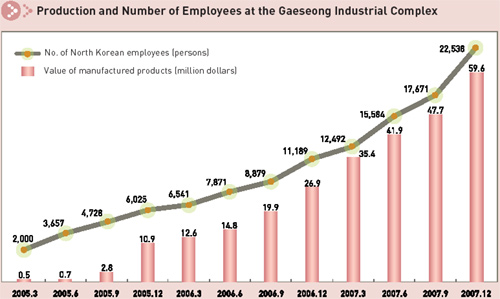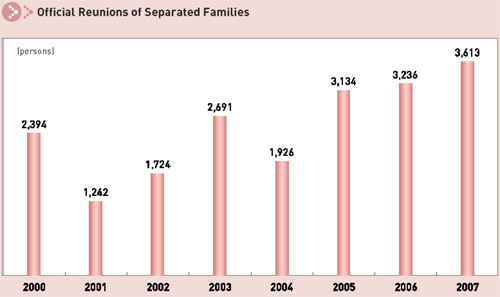When the Second World War ended with Japan's defeat, all Koreans aspired for a unified independent nation but instead suffered national division resulting from the subsequent Cold War between East and West. The national division and establishment of separate governments in the South and the North eventually led to a civil war, the Korean War (1950-1953). The Korean War was a by-product of internal ideological conflicts and was viewed by many as a proxy war between the West and the Communist bloc.
The Korean War developed into a large-scale international war drawing in 16 UN countries to fight together with the south as well as China and the USSR from the Communist Bloc. The fighting ended in an armistice, which created a 155-mile truce line dividing the Korean Peninsula.

The Korean War Veterans Memorial in Washington, D.C.
After the ceasefire, the Cold War confrontation on the Korean Peninsula intensified. The South Korean Government pursued a policy toward North Korea aimed at achieving unification by defeating Communism. At the same time, North Korea declared a strategy of a "revolutionary stronghold" and attempted to communize the South.
From the beginning of the 1970s, Cold War tensions began to ease, with capitalist and communist countries seeking d?ente. Against this backdrop, Seoul and Pyongyang simultaneously announced the South-North Joint Communiqu?of July 4, 1972, and initiated dialogue and exchanges on a limited scale, including the South-North Red Cross Talks and South-North Coordinating Committee Meetings. Nevertheless, it proved to be impossible to relieve the animosity and mistrust between the South and North or build mutual confidence in the political arena.
In 1979, the USSR invaded Afghanistan, which drove the world back to a new Cold War confrontation and turned inter-Korean relations sour. By the mid 1980s, reforms and openness in the USSR triggered an acceleration of reforms and opening in East European communist countries. As the Cold War began to be dismantled, inter-Korean relations reached an important turning point.
On July 7, 1988, in response to the easing of the Cold War internationally, the South Korean Government announced the Special Declaration in the Interest of National Self-Esteem, Unification and Prosperity. By 1990, inter-Korean relations had improved dramatically with the beginning of South-North High-Level Talks between the prime ministers.

The fifth round of the high-level talks in 1991
At the fifth round of the High-Level Talks in 1991, the two prime ministers signed the Agreement on Reconciliation, Nonaggression and Exchanges and Cooperation between the South and the North, also known as the Basic Agreement. It marked one step forward toward peace and unification on the Korean Peninsula.
Due to serious economic difficulties in North Korea, however, outsiders expected the regime to collapse. Furthermore, suspicions were raised about whether North Korea had developed nuclear weapons when it withdrew from the Nuclear Nonproliferation Treaty in March 1993. Due to these developments, tension on the Korean Peninsula heightened in the mid-1990s.

* Source: Ministry of Unification
The issue of a North Korean nuclear program caused inter-Korean relations to be nearly severed, and they only began to gradually improve as the Kim Dae-jung Administration (1998-2003) carried out a policy of reconciliation and cooperation, dubbed the Sunshine Policy. These efforts culminated in the first inter-Korean summit, which was held in Pyongyang in June 2000 and resulted in the June 15 South-North Joint Declaration.

* Source: Ministry of Unification
The inter-Korean summit served as a watershed in inter-Korean relations, ending five decades of confrontation and hostility in exchange for ties of reconciliation and cooperation.

Historic First South-North Korean Summit in 2000
Since June 2000, much progress has been made in inter-Korean relations. Dialogue has opened in various areas and reunions of separated relatives have commenced. In addition, there has been an increase in inter-Korean exchanges of personnel and goods.
The Roh Moo-hyun Administration (2003-2008) consistently pursued a peace and prosperity policy toward North Korea, which was based on the Kim Dae-jung Administration's Sunshine Policy. The second summit between South and North Korean leaders, which took place Oct.2-4, 2007, in Pyongyang, in particular is significant as it is the second meeting between the leaders amidst changing relations between the two Koreas and the larger Northeast Asian region. The two leaders discussed an array of pending issues such as as establishment of peace, co-prosperity, economic cooperation and reconciliation and reunification, announcing an eight-point "Declaration for Development in Inter-Korean Relations and Peace and Prosperity."
North and South Korea have stopped propaganda broadcasts against each other, taken down propaganda material at the Demilitarized Zone, and opened a military hotline.
Also, the two leaders have virtually ended the hostilities that have persisted for more than half a century and established a platform to ensure real peace and prosperity on the Korean Peninsula.